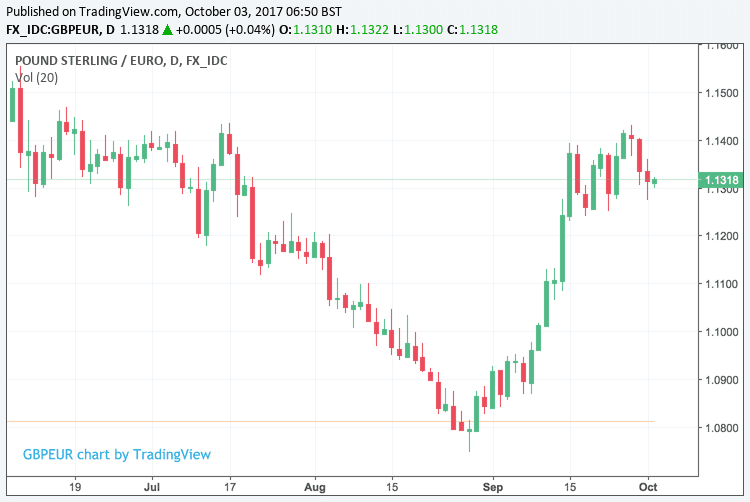Pound Sterling a Sell, the Euro a Buy say CIBC + Morgan Stanley but Others say the Worst has Passed
- Written by: Gary Howes

The GBP/EUR exchange rate is forecast to fall by strategists, but how severe any Sterling weakness will be remains a point of contention.
Foreign exchange strategists at CIBC Capital Markets are the latest to recommend clients sell Pound Sterling against the Euro arguing the recent bout of strength has completed.
CIBC believe the Pound has benefited in full from a shift in stance at the Bank of England where policy-makers surprised markets in September by saying an interest rate rise is necessary in the near-term.
Market pricing for a November interest rate rise is now above 70% having been around 10% ahead of September - the repricing helped the Pound-to-Euro exchange rate rally higher from levels sub-1.08 to highs at 1.14.
However, “a November BoE rate hike is now largely in the price for the GBP,” says Bipan Rai, a strategist at CIBC.
A dying Bank of England story coincides with fresh buying interest for the Euro observed at current prices which represent a key technical juncture for the exchange rate.
Strategists say they believe the Euro is due "another leg upwards from the current thick support levels".
Rai is looking to buy EUR/GBP at around the market price of 0.8817, and target a rise to the 0.9200 level over the coming weeks. Rai has advocated traders place their stop loss anywhere below the 0.8600 pence level as a break below this level would suggest the Pound may gain further on the common currency and so the trade is not going to work.
This gives us a sell on GBP/EUR at 1.1341, targeting a decline to 1.0869 with a stop-loss at 1.1628.
This target - we note - is commensurate with when markets were pricing a Bank of England interest rate rise as only happening in 2019, which we question. The subtext is that the market has to completely wipe away interest rate rises from the calendar and thus only see such a scenario were the Bank to bottle a November interest rate rise.
Of course the exchange rate could fall on Euro strength too. The Euro has torn higher through the course of 2017 as markets anticipate the European Central Bank's announcement that it will soon withdraw stimulus intended to support the Eurozone economy.
However with the political risk factor creeping back into the Eurozone and suggestions that the ECB is not going to rush to end its quantitative easing programme, we don’t see the conditions for such an agresssive move higher in the Euro to be repeated in the immediate term.
“We maintain a EUR/GBP buy-on-dips approach as we expect the mix of Euro strength and Sterling softness to persist," says Piet Lammens with KBC Markets in Brussels.
However, Lammens maintains a more conservative approach with regards to expectations for any decline in Sterling, which we believe to be realistic.
"The prospect of (limited) withdrawal of Bank of England stimulus puts a solid floor for Sterling short-term term," says Lammens.
Get up to 5% more foreign exchange by using a specialist provider by getting closer to the real market rate and avoid the gaping spreads charged by your bank for international payments. Learn more here.
Add to the Sell List
Yet, selling the Pound against the Euro is becoming an increasingly popular strategy being recommended by major institutions.
CIBC’s recommendation comes just days after strategists at American investment bank Morgan Stanley added the Pound to their “sell list” and said they are looking for opportunities to buy EUR/GBP.
“We think the risk/reward of being long GBP is not attractive and prefer selling into rallies,” says Hans Redeker, a strategist at the American bank, in a note last week.
Redeker flagged the Conservative Party conference, which began at the weekend, as a risk for the Pound because it could result in public commentary aimed at undermining the leadership of Prime Minister Theresa May.
But, at the heart of Redeker’s strategy is the idea that market expectations for the path of UK interest rate rises at the Bank of England are now excessive, which chimes Monday’s comment from Rai at CIBC.
"The AUD and GBP rate curves appear to be overpriced for next year or have reached limits, without a significant pick-up in economic data. Both these currencies are added to our sell list."
The Pound saw a rollercoaster ride during September. It came into the month under severe pressure, with rising inflation weighing on the consumer and the economy. Markets were also on edge about the absence of progress in negotiations over the UK’s departure from the EU.
But by the end of the month, the Bank of England had boosted the beleaguered currency by signalling an interest rate rise could be in the pipeline and markets were also soothed somewhat by tentative signs of a possible agreement on the so called divorce between the UK and the EU.
The Pound saw out the month of September having gained around 5% against the Euro, marking a near-complete reversal of 2017’s losses, although Monday’s commentary from CIBC and last week’s note from Morgan Stanley now place a question mark over this nascent change of fortunes.
But the Worst has Passed
While strategists - i.e. those tasked with looking for opportunities to profit on foreign exchange moves - are looking for a potential decline in Sterling, others in the analyst community are more optimistic.
Analysts at Scandanvian financial services giant SEB Markets argue that the worst has in fact passed for Sterling.
In a recent update on the currency's prospects, analyst Richard Falkenhall says most of the GBP recovery in September "is probably related to a repricing of expectations on BOE policy, which means that the GBP still trades with a significant Brexit risk premium."
Thus, any sign of progress in Brexit negotiations would probably reduce the risk premium and strengthen the GBP.
Falkenhall and his team have actually upgraded their forecasts for the GBP/EUR exchange rate as a result suggesting the worst has come to pass.
The exchange rate is seen at 1.15 by the end of 2017 and 1.19 at the end of 2018.
So wrapping these views together, there might well be a period of Sterling weakness in the near-term but ultimately the worst has passed and seeing the 2017 lows at 1.08 being tested again is unlikely.





